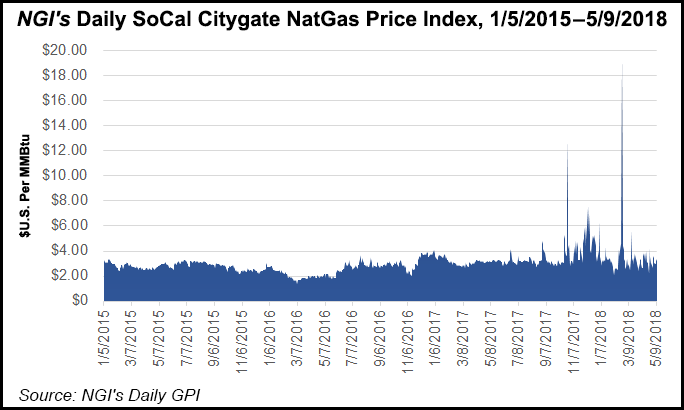Infrastructure | Markets | NGI All News Access | NGI The Weekly Gas Market Report
SoCal Summer Power Risks Said to Continue from Aliso Canyon, Pipeline Outages
Inadequate natural gas supplies for electricity generation in Southern California again will hover over the region this summer and cast doubts about next winter, according to an assessment unveiled by the California Energy Commission (CEC).

The forecast calls for a “significant number of pipeline outages,” which could raise energy reliability risks when combined with the continued restricted operations at the 86 Bcf 86 Bcf capacity Aliso Canyon facility north of Los Angeles.
Developed by the Aliso Canyon Technical Assessment Group, the new report is the fifth in a series launched following the 2015-16 storage well leak at the 3,200-acre facility.
“The challenges this summer stem primarily from continuing outages on four key natural gas pipelines,” dropping available pipeline capacity of 2.65 Bcf/d, “significantly lower than the 3.18 Bcf/d available last summer,” said a CEC spokesperson, citing the multi-agency assessment by the Aliso team. “As a result, the total system capacity, which is a combination of pipeline capacity and non-Aliso Canyon storage capacity, is some 200 MMcf/d lower than last year.”
In assessing risks for this summer, the report looked at one-in-10-year peak day basis, concluding that electric reliability can be maintained without using supplies from Aliso Canyon, assuming no problems on the electric transmission grid. The authors stressed, however, that operating the system at these levels curtails electric generation and could lead to increased costs.
There also is “no guarantee” that the California Independent System Operator or the Los Angeles Department of Public Works “would be able to secure the necessary electricity imports to move the system to minimum generation, especially on short notice,” the CEC spokesperson said.
“The availability of supply from alternative resources may be less this summer when compared to 2017 due to less-than-average hydroelectric conditions in 2018.”
A preliminary examination of the events of this past winter also is included in the latest report, noting that the Southern California Gas Co. (SoCalGas) “avoided serious problems” primarily because of warmer-than-normal weather. It also noted that a February cold snap sharply illustrated “how fast storage inventories can dwindle and how quickly storage withdrawal capacity declines.”
CEC staff recommended continuing most of the current mitigation measures and exploring additional measures that include buying liquefied natural gas to assure that up to 230 MMcf/d can reach Otay Mesa on a firm basis, and coordinating with gas customers to ensure they are prepared to respond to both high and low operational flow orders.
The recommendations also include It also includes authorizing SoCalGas to buy gas to fill the receipt points to capacity when operationally and financially feasible and expediting any pending transmission upgrades that would further reduce the minimum generation requirement.
© 2024 Natural Gas Intelligence. All rights reserved.
ISSN © 1532-1231 | ISSN © 2577-9877 | ISSN © 1532-1266 |
